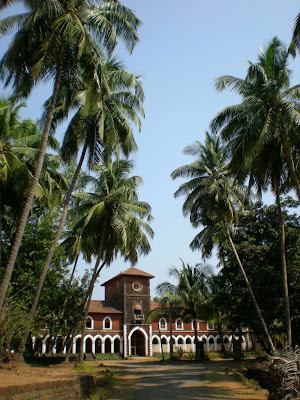
The red laterite of the royal palace overlooking the lake becomes visible as soon as one approaches Sawantadi. The reigning Bhonsle family, lived here in modest splendour, from the time of the kingdom’s absorption into the British Raj. British influence, much in contrast to neighbouring Goa, is in abundant evidence. Many of the supposedly historical clichés and stereotypes associated with Princely States come to life.
First, Lestor Gate, “opened for carriages and general use in 1895”, and which one still has to enter to reach the palace, was as its name suggests, British in inspiration and design. The same can be said of the palace. In some corners, it even resembles large farmhouses one finds in France. European influence is all pervasive. The royal durbar hall itself was designed by a certain “Lieutenant-Colonel E. P. Cambier R. E.” - whatever the last two initials mean. (Royal Engineers?) That is not all. Inside, behind the royal throne, lies a large bust of a typically grumpy looking Queen Victoria. It is one of the few places where she still holds a place of honour in India. In the museum section of the palace, there are interesting photographs of a bygone era revealing the close relations between the Princes and the British. One sees the same durbar hall (which has hardly changed since that era) filled with stiff looking English officials and elegantly dressed English ladies mingling with the royal family, while turbaned waiters stand sentry like nearby, amidst hunting trophies, a British flag and - of course – Queen Victoria. It makes one realise that the popular images of the Princely States are neither cliché nor stereotypical.
There are some indications that the British Raj, however, did come to an end. For example – and most ironically – at the other end of the hall, directly opposite the bust of Victoria, hangs a large painting of Shivaji. It might not be so ironic in itself had the kingdom of Sawantwadi not been a close ally of the Bijapur Sultanate and then the Mughal empire. History is apparently quickly forgotten when it comes to royal decoration. This irony, however, is partially explained by the fact that the painting was presented recently by a local school to the royal family. Where else to place a painting of Maharashtra’s most popular hero but the durbar. The British are no longer present to complain. One can only wonder what the bust of Queen Victoria feels staring at this intruder waving his sword at her everyday.
Inevitably, one finds the usual stuffed animal, in this case a leopard, proudly shot by his Royal Highness and displayed in a prominent glass enclosure. The hunting of rare animals was one of the most contemptible aspects of Princely Indian life, but it apparently remains a source of pride here. There is even a tiger positioned near the throne, although it is not clear if it stuffed or a fake. Either way, it is falling apart and could do with some restoration.
After the durbar one is escorted by the palace guide (compulsory not optional) to the museum. There one finds everything from bric-a-brac to precious antiquities – all presented as gifts to the royal family. Of particular interest are some ancient stone sculptures of Hindu gods going back to the 10th century. They are all the more interesting as much of the Hindu heritage in this region was ravaged by the Portuguese. (One rarely comes across such sculptures in Goa). The gifts are not only indigenous. They range from a Nepali idol to a Japanese World War II flag.






I am from Sawantwadi,
ReplyDelete(kajrekar Avaat/Baherchawada) seeing and reading all this i am very proud that my ancistors are from such good place.
I am from Sawantwadi,
ReplyDelete(pai priya)i am very glad and proud that am from that place.
Nice blog.......Thanks for providing such details. Author- Please post your name too
ReplyDelete